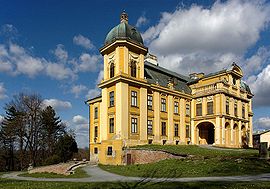Našice
| Našice | ||
|
||
|
|
||
| Basic data | ||
|---|---|---|
| State : |
|
|
| County : |
|
|
| Height : | 157 m. i. J. | |
| Area : | 200 km² | |
| Residents : | 16,224 (2011) | |
| Population density : | 81 inhabitants per km² | |
| Telephone code : | (+385) 031 | |
| Postal code : | 31 500 | |
| License plate : | N / A | |
| Structure and administration (status: 2013, cf. ) |
||
| Community type : | city | |
| Mayor : | Krešimir Žagar ( HDZ ) | |
| Website : | ||
 Pejačević Castle |
||
Našice [ ˈnaʃitsɛ ] (German outdated Naschitz ) is a city in Croatia that belongs to the Osijek-Baranja County .
geography
Našice is a small town in Slavonia , 50 km from Osijek , on the northern slope of the Krndija Mountains.
population
According to the 2011 census, the municipality of Našice has 16,224 inhabitants, 7,888 of which are the city itself. National structure:
- Croatians 14,284 (88.04%)
- Slovaks 1,078 (6.64%)
- Serbs 588 (3.62%)
- Other 274 (1.69%)
history
Našice is mentioned for the first time in 1229. There are various names in medieval documents: Nolko, Nolche, Negke, Nexe, Nekche, Vesice and Nesice. The secular lords of Našice and his possessions were the Aba, David Lacković, Ivan Korvin, Ivan and Nikola Gorjanski and the Ilok princes Ujlaky. From an ecclesiastical perspective, the Templars, Johanniter and Franciscans were the owners. Franciscans came to Našice in the second half of the 13th century and remain to this day. In the 14th century the church of St. Anton of Padua was built in the Gothic style and changed to Baroque style at the beginning of the 18th century. Našice was under Turkish rule from 1532 to 1687. In 1734 the Našice estate was bought by Count Pejačević , who kept it until 1945. Count Pejačević built the so-called “great castle” in 1811 and the Pejačević family has lived in the town ever since, taking part in the development of Našice.
The “little castle” is built for Marko VI, Teodor Pejačević's eldest son. In the revolutionary events of 1848, the Pejačević family was given the opportunity to intervene in the political life of Croatia. Count Ladislav Pejačević is appointed Croatian ban . Because of the reputation enjoyed by the Pejačević family, Count Teodor Pejačević was appointed Chief Count of the Virovitica County and, in 1903, the Croatian Ban. His daughter Teodora (Dora) Pejačević will be the first Croatian female composer to make her family and the town of Našice known. Dora was trained in Dresden and Munich . She showed excellent musical talent and learned to play the violin and piano. Her works were on the repertoires of many respected artists and her name on concert posters along with the world's greatest composers. Even before the First World War , the city had water pipes, telephones and electricity. In 1893 the railway line came to Našice, making the town an important transport hub. During the Second World War Našice suffered from destruction, the Pejačević castle became the seat of the German command and the Pejačević family left Našice. Later Našice becomes the center of the Croatian Spring in this part of Slavonia.
economy
The main focus of the economy in Našice is the NEXE group. The main industries are agriculture, fishing, metal processing, cement making, stone excavation, wood and food processing, etc.
Personalities
sons and daughters of the town
- Isidor Kršnjavi (1845–1927), painter, writer, politician
- Dora Pejačević (1885–1923), first Croatian composer
- Stanko Bilinski (1909–1998), mathematician
- Helena Buljan (* 1941), actress
- Dunja Rajter (* 1946), singer
- Branko Uvodić (* 1954), moderator
- Ivana Plechinger (* 1973), singer
- Danijel Pranjić (* 1981), football player
- Alen Blažević (* 1986), handball player
Other personalities
- Sandra Lončarić (* 1974), actress
Culture and sights
In Našice there is the church of St. Anthony of Padua , the library of the Franciscan monastery with 10 incunabula , the "old" and "new" castle of Count Pejačević (late baroque with classical elements) and the chapel with the mausoleum of Count Pejačević and the Grave of Countess Dora. The Pejačević Castle is now a museum. The castles are surrounded by a park. In the park there is a lake with a small island and the so-called "Doras Pavilion".
St. Martin's Church is located in Martin, three kilometers from Našice . It was built by the Crusaders at the beginning of the 13th century and is the only fully preserved Templar church in Croatia.
The Bizik family zoo is located in the surrounding Markovac Našički.
education
Today there are two primary schools in the city, as well as a middle school with many different fields of study.
Sports
In Našice there is a basketball club, tennis club and women's volleyball club "Našice", soccer clubs "Našk" and "Radnik Šipovac", but the most famous is the handball club "Nexe", which is in the Croatian first division.

